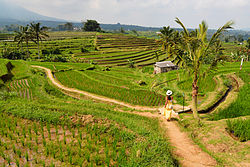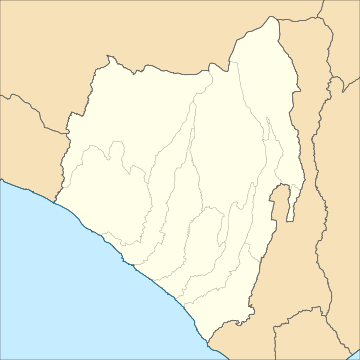Tabanan
Administrative districts
The regency is divided into ten districts (kecamatan), tabulated below with their areas and population totals at the 2010 census and the 2020 census, together with the official estimates as at mid 2022. The table also includes the locations of the district administrative centres, the number of administrative villages in each district (all classed as rural desa), and its postal codes.
| Kode Wilayah |
Name of District (kecamatan) |
Area in km |
Pop'n census 2010 |
Pop'n census 2020 |
Pop'n estimate mid 2022 |
Admin centre |
No. of villages |
Post codes |
|---|---|---|---|---|---|---|---|---|
| 51.02.01 | Selemadeg | 52.05 | 19,262 | 21,874 | 22,400 | Bajera | 10 | 82164 |
| 51.02.02 | Selemadeg Timur (East Selemadeg) |
54.78 | 21,154 | 23,826 | 24,300 | Megati | 10 | 82160 |
| 51.02.03 | Selemadeg Barat (West Selemadeg) |
120.15 | 18,809 | 21,079 | 21,500 | Antosari | 11 | 82162 |
| 51.02.04 | Kerambitan | 42.39 | 37,704 | 41,766 | 42,500 | Kerambitan | 15 | 82161 |
| 51.02.05 | Tabanan (district) | 51.40 | 70,526 | 76,235 | 77,300 | Tabanan (town) | 12 | 82111 - 82115 |
| 51.02.06 | Kediri | 53.60 | 84,215 | 90,491 | 91,600 | Kediri | 15 | 82121 - 82123 |
| 51.02.07 | Marga | 44.79 | 40,353 | 42,898 | 43,400 | Marga | 16 | 82181 |
| 51.02.09 | Baturiti | 99.17 | 46,425 | 51,381 | 52,300 | Baturiti | 12 | 82191 |
| 51.02.08 | Penebel | 141.98 | 44,104 | 49,637 | 50,700 | Penebel | 18 | 82152 |
| 51.02.10 | Pupuan | 179.02 | 38,361 | 42,443 | 43,200 | Pupuan | 14 | 82163 |
| Totals | 839.33 | 420,913 | 461,630 | 469,340 | 133 |
The administrative centre of Selemadeg District is at Bajera, that of Selemadeg Timur is at Megati, and that of Selemadeg Barat is at Antosari; the other districts share the same name as their administrative centre. Kediti and Tabanan Districts in the southeast of the regency are within the official metropolitan area of Greater Denpasar (Sarbagita); Pupuan, Selemadeg Barat, Selemadeg, and Selemadeg Timur Districts together constitute the western half of the Regency.
-
Districts in Tabanan Regency
Jatiluwih

Jatiluwih is an administrative village in Penebel District, north of Tabanan; it is formed with two customary villages, Gunung Sari and Jatiluwih; under these two customary villages there are seven customary hamlets or banjar. The village is at an altitude of 700 meters. Two routes to Jatiluwih are Denpasar > Kediri > Tabanan > Penebel > Jatiluwih or Denpasar > Mengwi > Baturiti > Jatiluwih.
It has terraced paddy fields following the contours of land against the background of Mount Batukaru and Mount Agung. These terraces use the traditional Balinese irrigation known as subak, Bali's community-based water control management system.
Jatiluwih rice terraces are one of the five areas that make up UNESCO's world's cultural heritage site listed for the subak.
In the early 1990s, Jatiluwih was one of three villages chosen for a pilot project aiming at developing village tourism, as an alternative to mass tourism that has been overtaking Bali. The government argued that this project would be under local management and would therefore be of more benefit to the local community. At the time, the initiative failed to attract a significant amount of tourist visits; and the revenues it generated had frequently been a source of conflict. Thus many villagers argued that this tourism project failed to reach its objectives.
Tourism development control
To preserve the largest area of 53,000 hectares of agriculture fields on the island, the Tabanan Regency Administration does not allow the development of star-rated city hotels anymore. Tourism facilities with a commitment to environmental conservation are allowed, with 30 % land surface for buildings and 70 % land surface to be left natural as paddy fields or other plantations. The administration has also decided a 300-hectare protected zone of paddy fields, and a 100-hectare housing zone outside the protected zone.
For visitors, it is possible to visit the 300-hectare on foot (about 31⁄2 hrs trekking) or with an e-bike tour that the local villagers have organized since 2017 (about 1 hour).
Puri Anyar Kerambitan
Puri Anyar Kerambitan ("new palace of Kerambitan"), in Baturiti, is one of the three royal palaces (puri) in Kerambitan district. It was built in the 1620's by the 12th king of Tabanan for his second son - the first son having inherited Puri Agung Kerambitan, at that time the only existing palace. Each palace received more than 100 hectares of land and the proceeds of said land. Large ceremonies for the community were held there. Foreign dignitaries visited for trade agreements and other affairs. Among the gifts that they brought were many ceramic plates, original Delftware (Delft Blue) from Holland, which ended up embedded as adornments into building walls and temple shrines; they can still be seen there to this day.
After the Indonesian independence (1945) came the Land Reform Law in 1961 and the land was taken away, leaving the puri with no income for its maintenance. Pak Oka, heir at that time, opened the palace to the public, as a centre of ceremonies but also of cultural celebration: ‘Royal Dinners’ were held, showcasing local dances and cultures. From 1967, Puri Anyar Kerambitan became a social hub. Among the visitors were David Bowie, King Hussein of Jordan, Dewi Sukarno, Mick Jagger (who visited 3 times as he hoped to learn the tektekan dance, not realising it was a sacred trance dance). Income was thus provided to maintain the palace and temple.
Then came in mass tourism and quick fixes, and out went the celebrities - and the income. The present heir, Ibu Giri Putri, has undertaken the task of restoring the temple. The whole place has a considerable historical value: it is one of the last palaces to retain its original structure. Its middle courtyard (jabah tengan) has not changed for 400 years; nor has the layout of the whole compound, built according to the principles of kosala-kosali, respecting the rules about the cardinal directions in relation to the human anatomy. The wood of the bale pavilions is also originel, with ancient patterns of prada etched into the pillars. Five families of royal descent live there
Climate
Tabanan has a tropical rainforest climate (Af) with moderate rainfall from April to September and heavy rainfall from October to March.
| Climate data for Tabanan | |||||||||||||
|---|---|---|---|---|---|---|---|---|---|---|---|---|---|
| Month | Jan | Feb | Mar | Apr | May | Jun | Jul | Aug | Sep | Oct | Nov | Dec | Year |
| Mean daily maximum °C (°F) | 30.4 (86.7) |
30.5 (86.9) |
30.6 (87.1) |
31.1 (88.0) |
30.8 (87.4) |
30.1 (86.2) |
29.4 (84.9) |
29.5 (85.1) |
30.3 (86.5) |
31.1 (88.0) |
31.2 (88.2) |
30.8 (87.4) |
30.5 (86.9) |
| Daily mean °C (°F) | 26.3 (79.3) |
26.3 (79.3) |
26.2 (79.2) |
26.3 (79.3) |
26.0 (78.8) |
25.3 (77.5) |
24.9 (76.8) |
24.9 (76.8) |
25.6 (78.1) |
26.3 (79.3) |
26.5 (79.7) |
26.4 (79.5) |
25.9 (78.6) |
| Mean daily minimum °C (°F) | 22.2 (72.0) |
22.2 (72.0) |
21.9 (71.4) |
21.6 (70.9) |
21.2 (70.2) |
20.5 (68.9) |
20.4 (68.7) |
20.4 (68.7) |
20.9 (69.6) |
21.5 (70.7) |
21.9 (71.4) |
22.1 (71.8) |
21.4 (70.5) |
| Average rainfall mm (inches) | 314 (12.4) |
260 (10.2) |
221 (8.7) |
102 (4.0) |
111 (4.4) |
110 (4.3) |
135 (5.3) |
69 (2.7) |
108 (4.3) |
213 (8.4) |
237 (9.3) |
298 (11.7) |
2,178 (85.7) |
| Source: Climate-Data.org | |||||||||||||
Notes and references
Notes
- ^ kosala-kosali, similar to feng shui, is a complex system of architecture deeply intertwined with Balinese culture and spirituality. Its rules are described in a lontar known as Kosala Kosali, dating from the arrival of the Aryans from the Majapahit kingdom to Bali. It results in an architecture called Bali Arya's architecture.
- ^ Prada is the gilding of objects, architecture or cloth. Usually in gold, silver can also be used.
References
- ^ Badan Pusat Statistik, Jakarta, 2023, Kabupaten Tabanan Dalam Angka 2023 (Katalog-BPS 1102001.5102)
- ^ Biro Pusat Statistik, Jakarta, 2011.
- ^ Badan Pusat Statistik, Jakarta, 2021.
- ^ Wardana 2015, p. 3.
- ^ The Jakarta Post (ed.). "Jatiluwih's beautiful terraced rice fields". Archived from the original on 2011-06-07.
- ^ "Cultural Landscape of Bali Province: The Subak System as a Manifestation of the Tri Hita Karana Philosophy". whc.unesco.org.
- ^ Wardana, Agung (2015). "World Heritage-Making in the Pluralistic Legal-Institutional Setting of Catur Angga Batukaru, Bali". academia.edu (Australian Research Council International Workshop: “Intangible Cultural Heritage Across Borders: Laws, Structures and Strategies in China and its ASEAN Neighbours”). School of Law, Deakin University, Melbourne, 15-17 April 2015. Retrieved 2024-05-11.
{{cite web}}: CS1 maint: location (link) See p. 2. - ^ Speirs, Edward (October 2, 2018). "Puri Anyar Kerambitan : A Palace of History". nowbali.co.id. Retrieved 2024-05-28.
- ^ Arthana, Nyoman Nuri (2019). "The knowledge building of construction process of Bali Arya's architecture: interpretation of the manuscript Asta Kosala Kosali". Journal of Architectural Research and Education. 1 (2): 168–175. Retrieved 2024-05-28.
- ^ Nandaryani, Ni Wayan; Brahmanta, I Wayan Agus Palguna (October 2020). "Aesthetics of form and function of dulang Bali". International Proceeding Conference on Multimedia, Architecture & Design (IMADe). 1: 383, 385, 389, 390. Retrieved 2024-05-28.
- ^ "Photo of a wall sculpture adorned with prada". dreamstime.com. Retrieved 2024-05-28.
- ^ "Prada Papua". iwarebatik.org. Retrieved 2024-05-28.
- ^ "Climate: Tabanan". Climate-Data.org. Retrieved 17 November 2020.
External links
 Tabanan travel guide from Wikivoyage
Tabanan travel guide from Wikivoyage Media related to Tabanan Regency at Wikimedia Commons
Media related to Tabanan Regency at Wikimedia Commons- (in Indonesian) Official website
